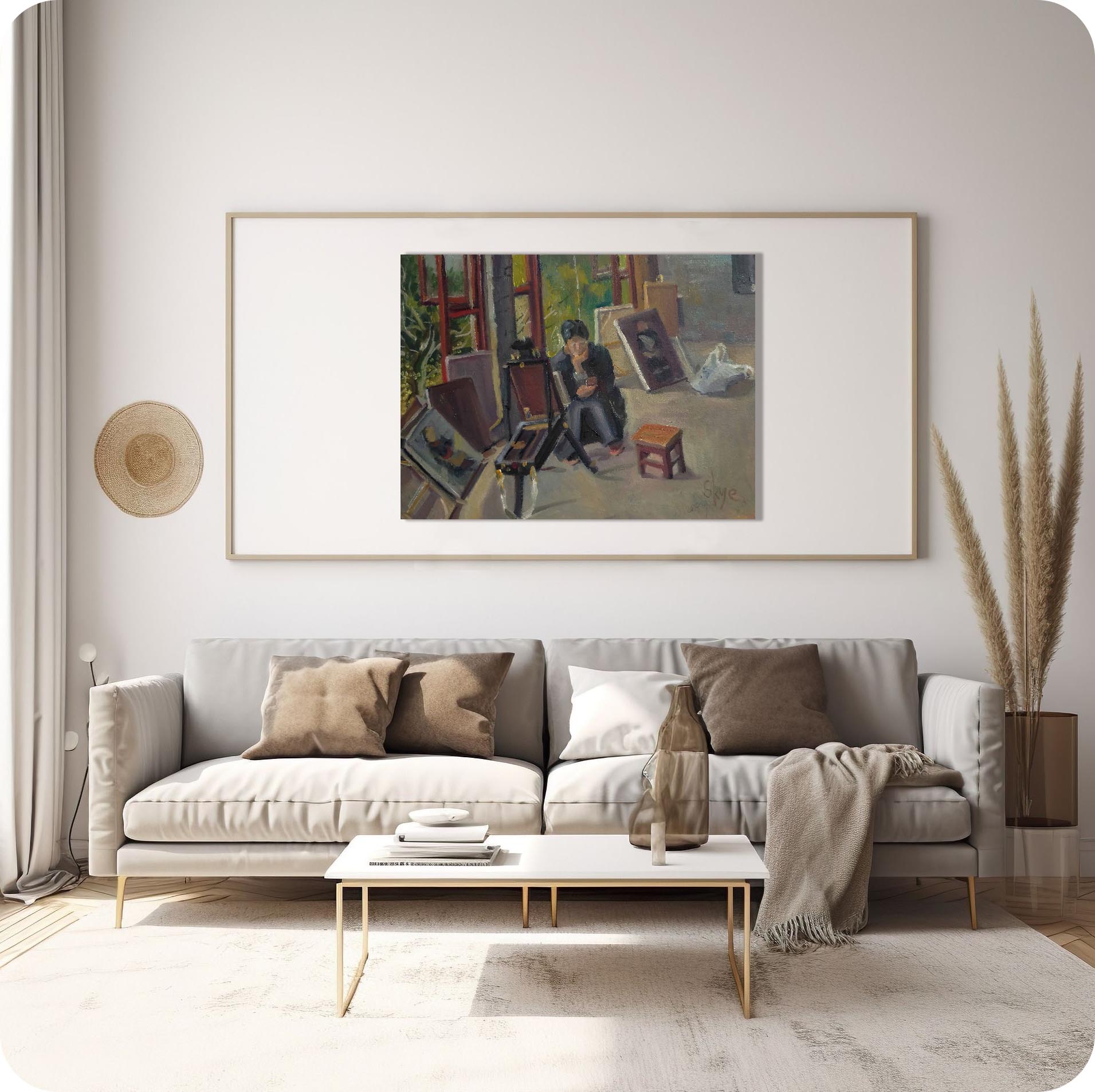This painting was created in 2018. With the end of the sketching class this year, my sketching journey stopped at a few simple drawings for Miss Hui. Of course, my oil painting skills have also improved a lot in the past year or so, and I have carefully explored my own way of speaking.
Overall Size:
Size without the frame:
Country: China
Date: 2018
Materials: Oil paint on linen
Condition: well preserved
Creative themes and style | My works revolve around the creative concept of "The land of humanity, People on the land". The people in the painting are people in nature, and the lines, shapes, and colors are close to nature. The nature in the painting is nature in the eyes of humans, existing in interaction with humans.I don’t pursue a series of works with a fixed and continuous style. I hope that the style of the pictures will synchronize with the changes in my life and always remain oscillating. The performance of the work must be in sync with the development of one's own life in order to be Sincere and powerful. Ideas are later.
An Interview with Artist Philo by Artphiloso Gallery
If you would like to collect this artwork or know more about the artist, please contact us.

The forms of the figure and painting tools are rendered with generalized brushstrokes. The figure’s relaxed posture and the casual arrangement of the implements evoke Bonnard’s poetic capture of everyday interiors, yet carry an added layer of informality. This condenses the studio's lived-in atmosphere and artistic aura into immediate visual symbols.
The composition breaks with rigid order. Painting tools, artworks, and the figure are scattered naturally within the space, seemingly recreating the authentic clutter and vitality of a working studio. This creates a "lived-in" quality reminiscent of Vuillard’s interior scenes, inviting the viewer’s gaze to wander among the objects and sense the unique ecology of an artistic environment. Each tool and painting serves as a silent footnote to artistic exploration.
The color palette centers on soft, warm grays and yellow-greens. Sunlight filtering through the window casts dappled light, suffusing the scene with warmth – an extension of Bonnard's color philosophy, using subtle tones to convey spatial temperature. The deep hues of the tools and the mottled colors of the artworks collide against this gentle base, highlighting the weight of artistic creation while retaining the approachability of a daily scene.
The brushwork is informal and imbued with a sense of lived experience. Impasto builds the texture of the tools, while light scumbling renders the softness of light and shadow. This recalls Utrillo’s rendering of urban street corners, infusing the painter’s familiarity and affection for the studio into every detail through the marks themselves. Thus, a static scene pulses with the daily rhythm of artistic creation.
Content and theme use this studio corner to present a slice of the artist-creator’s existence. The figure’s contemplation amidst the cluster of tools speaks of the solitude and perseverance inherent in artistic creation. Emotional expression is understated yet sincere. Through the faithful rendering of space and the warmth of the brushwork, it conveys a deep love and dedication to the artistic path, evoking empathy for the behind-the-scenes reality of creation. It is a silent homage to those who cultivate art.
Stylistically similar works: Bonnard’s The Artist's Studio (L'Atelier), which paints domestic life with poetic brushwork; Vuillard’s The Artist's Studio (L'Atelier), conveying a lived-in quality through "immersive" composition; Utrillo’s Rue de Montmartre, capturing a scene's warmth through informal brushwork. These works can be explored alongside this untitled painting to delve into the profound poetry found within the everyday life of art.
A1: The work portrays a brightly lit studio where a figure sits in deep thought, head slightly lowered. Around them lie scattered easels, sketches, frames, and a canvas bag. Through the window, one can glimpse lush greenery outside, adding a sense of freshness and openness to the overall atmosphere.
A2: This posture conveys a moment of pause and reflection—perhaps contemplating the artwork, reconsidering technique, or simply resting in fatigue. The act of learning and creating is rarely constant passion; it naturally alternates between momentum, hesitation, and silence.
A3: The scene contrasts the bright greens and orange-red window frames with the figure’s darker clothing. The interplay between the natural world outside and the quiet concentration inside creates a dialogue of “external freedom versus internal reflection.” The color scheme remains warm and understated, reinforcing a calm, contemplative mood.
A4: These everyday items are left deliberately unarranged, reflecting the authenticity of a working studio. They function less as decoration and more as witnesses of the artistic process, symbolizing practice, incompletion, and the ongoing journey of study.
A5: This painting is a quiet vignette about learning and pause. It avoids grand narratives, instead capturing an intimate moment of artistic self-reflection. Compared to the weightiness of works like The Outsider on the Tower Crane, this piece feels more personal and gentle—almost like a mirror of the artist’s own inner state.
A: Click here to view ARTPHILOSO's Guide for Collectors.
